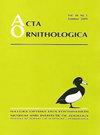波兰东北部大鹬雄性体色的季节性变化
IF 1.3
4区 生物学
Q3 ORNITHOLOGY
引用次数: 0
摘要
在有韭葱交配系统的鸟类物种中,雄性交配的成功通常与在韭葱处待的时间有关,这表明韭葱的出现有很强的选择性。我们对波兰5个繁殖季节的大鹬雄性的蜕皮情况进行了研究,发现与明显矛盾的是,75%的雄性在一个繁殖季节内蜕皮多次。在平均31天的追踪中,有gps标记的个体访问了多达9个不同的韭葱,经常在几个小时内快速连续访问2-3个韭葱。两个leks之间的转换完全是夜间的,在午夜之前达到顶峰。大部分改变了斑疹的雄斑疹迁移到原斑疹50公里范围内,但有10%的雄斑疹分散到100公里以外。在繁殖季节,雄性雄性通常会在不同的雏鸟之间进行多次转换(中位数= 4),大多数流动鸟类会改变20次以上的展示地点。雄性换套概率呈季节性变化,繁殖季节前期不换套,繁殖季节后期变化频繁。每天换韭黄的概率在个体间差异较大,可以区分出从不换韭黄和很少换韭黄(平均每天换韭黄的概率为0.02)和经常换韭黄(平均每天换韭黄的概率为0.23)两组雄性。这种雄性雄性交配行为的异质性与交配进化的“热枪”情节是一致的。在这里,与排名靠前的雄性相比,交配机会低的雄性应该从交配转换中受益,因为改变展示地点可能会让它们找到交配机会更高的雄性。此外,不管它的直接成功或失败,换羊可以被视为一种勘探行为,将在未来的繁殖季节获得回报。与此相一致的是,我们的许多换种雄性动物以一种表明知情分散的方式移动。应该使用现代跟踪设备评估欧洲不同大鹬种群中季节性内泄漏转换的流行程度,因为这种行为可能比许多先前研究中报道的要广泛得多。本文章由计算机程序翻译,如有差异,请以英文原文为准。
Intra-Seasonal Lek Changes of Great Snipe Gallinago media Males in the Northeast of Poland
In bird species with a lek mating system, male mating success is usually correlated with time spent at the lek, suggesting strong selection for lek attendance. We studied the lekking of Great Snipe Gallinago media males over 5 breeding seasons in Poland and found that, in apparent contradiction, 75% of males changed leks, often several times, within a single breeding season. GPS-tagged individuals tracked for an average of 31 days visited up to 9 different leks, often visiting 2–3 leks in quick succession within a few hours. Transitions between leks were entirely nocturnal, peaking before midnight. The majority of males that changed leks moved to sites within 50 km of the original lek, but 10% of males dispersed more than 100 km. Lek-switching males typically made several transitions between leks during the breeding season (median = 4), with most mobile birds changing display sites more than 20 times. Lek-switching probabilities showed seasonal variation, with no males changing leks early in the breeding season and frequent changes thereafter. The daily probability of lek change showed large inter-individual variation, allowing two groups of males to be distinguished, those who never or rarely changed leks (mean daily probability of lek change 0.02) and those who frequently changed leks (mean daily probability of lek change 0.23). This type of heterogeneity in male lekking behaviour is consistent with the hot-shot scenario of lek evolution. Here, lekking males with low mating chances should benefit from lek-switching — in contrast to top-ranking males — because changing display site may allow them to find leks with higher mating chances. Furthermore, regardless of its immediate success or failure, lek-switching can be seen as a form of prospecting behaviour that will pay off in future breeding seasons. Consistent with this, many of our lek-switching males moved in a way that suggests informed dispersal. The prevalence of intraseasonal lek switching in different Great Snipe populations across Europe should be assessed using the modern tracking devices, as this behaviour is likely to be much more widespread than reported in many previous studies.
求助全文
通过发布文献求助,成功后即可免费获取论文全文。
去求助
来源期刊

Acta Ornithologica
生物-鸟类学
CiteScore
2.10
自引率
0.00%
发文量
14
审稿时长
>12 weeks
期刊介绍:
Publishes scientific papers (original research reports, reviews, short notes, etc.) and announcements from all fields of ornithology. All manuscripts are peer-reviewed.
Established in 1933 as Acta Ornithologica Musei Zoologici Polonici, since 1953 continued under the present title.
Published twice a year by the Natura Optima Dux Foundation under the auspices of the Museum and Institute of Zoology, Polish Academy of Sciences.
 求助内容:
求助内容: 应助结果提醒方式:
应助结果提醒方式:


